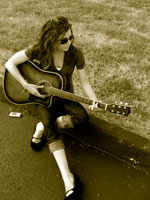What This Is
Chrysta Brown
 “What is that?” It’s more of a reprimand than a question. Across the street is an abandoned umbrella. Its metal arms are upturned and outstretched like a toddler who has only just learned to walk, or even better, to fall.
“What is that?” It’s more of a reprimand than a question. Across the street is an abandoned umbrella. Its metal arms are upturned and outstretched like a toddler who has only just learned to walk, or even better, to fall.
“It’s art,” I tell him. “This site-specific installment asks when an object, idea, or even human, is broken past the point of value.” We stop. I shift my green umbrella to cover more of me and less of us. Sharing umbrellas has never been a part of my skill set. Perhaps this too is a metaphor.
“What?” he shakes his head. “It’s not art. Somebody’s umbrella flipped and rather than walking five steps to the garbage they threw it on the sidewalk.”
“You are the enemy of metaphor,” I tell him indignantly.
I am only joking, but at the same time I want there to be more to the story of the discarded umbrella. I need the object in front of me to be a sign or a symbol, which I think may be to say that I need it to be something else, something universal, at the very least, something worthy of an academic nod-and-hum. This is the same need that read the Winnie the Pooh quote, “No one can be uncheered by a balloon,” and wondered, “What does the balloon mean?” Of course it means something because it is not at all possible that A.A Milne saw a balloon against a rainy-day sky and thought, “Well, that’s nice.” No, the simplicity of that explanation is unacceptable, even if it may be true.
During the 1950s, modern dance choreographer Merce Cunningham did something revolutionary with his dances. Where prior to this popular productions were about the dancers’ relationship with a story or the music, Cunningham created dances about dance. He gave dance the opportunity to be valuable and important by giving it the freedom to be about itself. In doing so, he challenged audiences appreciate what was right in front of them. “For me,” Cunningham wrote in an essay titled “Space, Time and Dance,” “it seems enough that dancing is a spiritual exercise in physical form, and that what is seen, is what is.” What a challenge this is for minds programmed to value the implication rather than the object. Can we challenge ourselves to look at a thing and value it for what it is, and not what we, for whatever personal reasons that color our experience, need it to be?
Our walk stops on a pier. Boats are docked at the edge of an ocean where wind rouses waves to dance back and forth against a vacant beach. A peach-shaded sun pokes its rays through a sky swirled with blues and grays. I want to comment on textural juxtaposition. I want to talk about beauty in the midst of such an ominous scene. I suppose I want to be thought of as clever and cosmopolitan for noticing it all. But what I need to do is be quiet. This is not a catalyst for an ancient discussion. This is a storm and a shore. This is water and sky. This is us standing quietly and watching it all.
(Art by Maggie Taylor)


